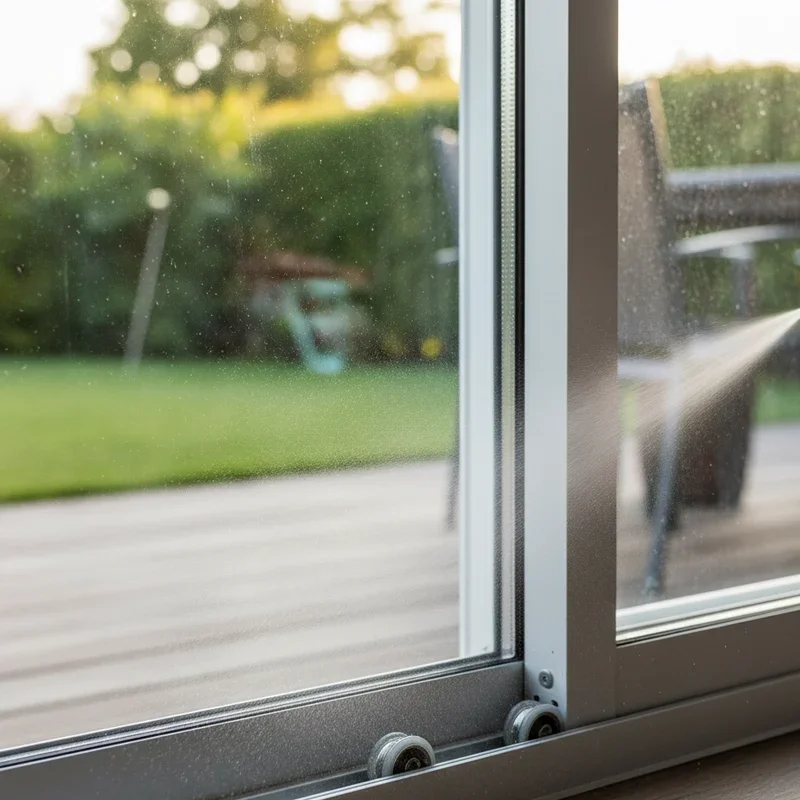How to Lubricate a Sliding Glass Door for Smooth Use
Learn how to lubricate a sliding glass door for smooth use with easy steps. Fix sticky doors, choose right lubricants, and maintain perfectly!
Ugh, there it goes again! That horrible grinding sound as you wrestle with your sliding glass door, putting your back into it just to open it a few inches. Sound familiar? Well, you're not alone in this struggle, my friend. Millions of homeowners deal with stubborn sliding doors that seem to have developed a mind of their own, refusing to budge without a fight. But here's the thing: your door doesn't hate you, it's just crying out for some TLC!
Remember when that door used to glide effortlessly with just a gentle push? Those were the days, right? The good news is, you can absolutely get back to that smooth-as-silk operation without calling in the pros or replacing the whole door. Learning how to lubricate a sliding glass door for smooth use isn't rocket science, and with the right know-how and a bit of elbow grease, you'll have that door sliding like it's on ice.
Before we dive into the nitty-gritty, let's bust a common myth: spraying WD-40 everywhere isn't the magic solution many folks think it is. In fact, it might make things worse in the long run! Proper door maintenance is about using the right products in the right places, and timing is everything. Whether your door's making sounds like a haunted house or requiring Olympic-level strength to open, we've got you covered with solutions that actually work.
Understanding Your Sliding Glass Door's Anatomy
The Track System: Where the Magic Happens
Let's get acquainted with what makes your sliding door tick, shall we? The track system is basically the highway your door travels on, and just like any road, it needs to be clear and well-maintained. You've got two tracks to worry about: the bottom track that bears most of the weight and does the heavy lifting, and the top track that keeps everything aligned and prevents your door from tipping over.
The bottom track is where most problems start brewing. It's like a magnet for dirt, leaves, pet hair, and whatever else finds its way there. Over time, this gunk builds up and creates resistance, turning your smooth operator into a stubborn mule. The track material matters too; aluminum tracks are common but can develop grooves and wear patterns, while steel tracks are tougher but prone to rust if not properly maintained.
Rollers: The Unsung Heroes
Hidden beneath your door frame are the real MVPs of smooth operation: the rollers. These little wheels carry the entire weight of your door, which, depending on the size, can be anywhere from 100 to 400 pounds! No wonder they need some love and attention. Most sliding doors have adjustable rollers, which is fantastic because it means you can fine-tune your door's performance without replacing parts.
Rollers come in different flavors: steel, nylon, or plastic. Steel rollers are durable but can be noisy and need regular lubrication. Nylon rollers are quieter and self-lubricating to some extent, but they wear out faster. Knowing what type you have helps determine the best maintenance approach. If your rollers are visibly cracked, flat-spotted, or frozen in place, well, lubrication alone won't save the day.
Weather Stripping and Seals
While not directly involved in the sliding mechanism, weather stripping plays a supporting role in your door's performance. When these rubber or vinyl seals get old and crusty, they can create drag against the door, making it harder to open. Plus, damaged weather stripping lets in drafts, bugs, and moisture, which can accelerate track deterioration.
Signs Your Door is Screaming for Lubrication
The Symphony of Sounds
Is your door composing its own soundtrack every time you use it? Different sounds tell different stories. A grinding or scraping noise usually means dirt in the tracks or worn rollers struggling against resistance. Squeaking or squealing? That's typically dry rollers begging for lubrication. A popping or clicking sound might indicate the door is jumping the track slightly due to misalignment or obstruction.
Paying attention to when these sounds occur matters too. If it's worse in the morning or after the door hasn't been used for a while, you're likely dealing with lubricant that's gotten thick or gummy. If the noise gets progressively worse throughout the day, heat expansion might be playing a role, or you've got a lubrication breakdown happening.
Physical Resistance and Sticking Points
When opening your door feels like a workout, something's definitely amiss. Does it stick at certain points along the track? That could indicate localized dirt buildup or track damage. If the resistance is consistent throughout the entire range of motion, you're probably looking at a general lack of lubrication or roller problems.
Here's a quick test: try lifting the door slightly while sliding it. If it suddenly moves easier, your rollers are likely the culprit. They might be worn, misadjusted, or desperately need cleaning and lubrication. On the flip side, if lifting doesn't help, the track itself is probably the issue.
Preparing for How to Lubricate a Sliding Glass Door for Smooth Use
Gathering Your Arsenal
Before starting this mission, let's make sure you've got all the right tools and supplies. Trust me, having everything ready beats running to the hardware store mid-project with greasy hands! Here's your shopping list:
• Vacuum cleaner with crevice attachment • Stiff-bristled brush (an old toothbrush works great) • Soft cloths or paper towels • Mild detergent or degreasing solution • Silicone-based lubricant spray • Graphite lubricant (optional but recommended) • Screwdriver set for adjustments • Safety glasses (debris loves jumping into eyes) • Drop cloth or old newspapers • Steel wool or fine sandpaper for stubborn spots • A helper (doors are heavy, and four hands beat two)
Safety First, Folks!
Working with sliding doors isn't particularly dangerous, but let's not tempt fate. These doors are heavier than they look, and if one decides to come off its track while you're working on it, you'll have a bad day. Always have someone help you if you need to remove the door. Lock the door in place or use a wooden block to prevent it from sliding while you're working on the tracks.
Wear those safety glasses! When you're cleaning out tracks, debris has a nasty habit of flying up at your face. And here's a pro tip: work on a mild day if possible. Metal tracks can be scorching hot in summer or freezing cold in winter, making the job unnecessarily uncomfortable.
The Deep Clean: Foundation for Smooth Operation
Vacuuming and Brushing the Tracks
Alright, time to get down and dirty! Start by opening your door halfway to expose as much track as possible. Using your vacuum's crevice attachment, suck up all the loose debris, dead bugs, and mysterious crud that's accumulated. Don't be gentle; really get in there. You'd be amazed at what comes out of seemingly clean tracks.
After vacuuming, break out that stiff brush and scrub the tracks thoroughly. Pay special attention to the corners and edges where grime loves to hide. For stubborn buildup, a flathead screwdriver wrapped in cloth can help scrape without scratching. If you encounter what looks like black grease or tar-like substance, that's probably old lubricant mixed with dirt, and it definitely needs to go.
Cleaning the Rollers
Here's where things get interesting! To properly clean the rollers, you'll need to access them, which usually means partially removing the door. Don't panic; it's easier than it sounds. Most sliding doors have adjustment screws at the bottom that allow you to raise the door enough to clear the track. With your helper, carefully lift and angle the bottom of the door out.
Once you can see the rollers, assess their condition. Spin them by hand; they should rotate freely without grinding or wobbling. Clean them with degreasing solution and a brush, removing all the built-up gunk. If they're damaged or won't spin freely even after cleaning, replacement might be necessary. But let's stay optimistic and assume a good cleaning will do the trick!
Addressing Track Damage
While everything's exposed, inspect the tracks for damage. Small dents can often be gently hammered out with a rubber mallet and a block of wood. Rough spots can be smoothed with fine sandpaper or steel wool. If you find significant damage like deep grooves or cracks, you might need to replace the track section, but minor imperfections can usually be worked around.
Choosing the Right Lubricant
Silicone Spray: The Gold Standard
When it comes to how to lubricate a sliding glass door for smooth use, silicone spray is your best friend. It's specifically designed for this type of application, providing long-lasting lubrication without attracting dirt like oil-based products do. Silicone spray dries to a slick film that reduces friction while repelling water and resisting temperature extremes.
Look for products specifically labeled for door and window use. These formulations often include additives that help protect against UV damage and prevent degradation of rubber seals. Avoid generic silicone sprays meant for automotive use, as they might contain petroleum distillates that can damage weather stripping.
What About WD-40?
Ah, WD-40, the duct tape of the lubricant world! While it's great for many things, it's not ideal for sliding door tracks. WD-40 is primarily a water displacer and penetrant, not a long-term lubricant. It'll make your door slide great for about a week, then it'll attract dirt and leave you worse off than before. If you must use it, consider it a temporary fix while you get proper lubricant.
Alternative Lubricants
Graphite powder is old-school but effective, especially for locks and upper tracks where liquid lubricants might drip. It's basically powdered carbon that provides dry lubrication without attracting dirt. The downside? It's messy and can stain if you're not careful.
White lithium grease is another option, particularly for roller bearings. It's thicker than silicone spray and stays put better, but it can attract some dirt over time. Paraffin wax works too; just rub it along the track like you're coloring with a crayon. It's clean, effective, and won't attract dirt, but it needs more frequent reapplication.
The Lubrication Process Step by Step
Applying Lubricant to the Tracks
Now for the main event! Start with completely clean, dry tracks. Shake your silicone spray well, then apply a thin, even coat along the entire length of both top and bottom tracks. Don't go crazy; more isn't better here. A light coating is all you need. The key is even coverage without pooling or dripping.
Work in sections, spraying about two feet at a time, then moving the door to expose the next section. This ensures you don't miss any spots. For the bottom track, focus on the areas where the rollers actually make contact. You can usually see wear patterns that show you exactly where to concentrate your efforts.
Lubricating the Rollers
With the door still partially removed or raised, spray the rollers directly while rotating them by hand. This helps work the lubricant into the bearings where it's needed most. If your rollers have visible bearings or adjustment mechanisms, give those a light spray too. Just be careful not to oversaturate, as excess lubricant can drip onto your floor.
For plastic or nylon rollers, go easier on the lubricant. These materials can sometimes swell or degrade with too much chemical exposure. A light misting is usually sufficient, as these rollers are somewhat self-lubricating by design.
Don't Forget the Lock and Handle
While you're at it, show some love to the locking mechanism and handle. These parts take a beating from daily use and weather exposure. A shot of graphite lubricant in the lock cylinder keeps it operating smoothly and prevents freeze-ups in winter. The handle mechanism benefits from a light application of silicone spray on any moving parts.
Fine-Tuning and Adjustments
Adjusting Roller Height
After lubrication, you might need to adjust the roller height for optimal performance. Most sliding doors have adjustment screws at the bottom, hidden behind plastic caps. Turning these screws raises or lowers the door, affecting how it sits in the track and how much clearance it has.
The goal is to have the door sitting level with even gaps at the top and sides. Too low, and it'll drag on the bottom track. Too high, and it might jump out of the track or let in drafts. Make small adjustments, testing the door's operation after each turn. It's like tuning a guitar; small tweaks make big differences.
Aligning the Door
Sometimes, despite your best lubrication efforts, the door still doesn't slide right. This often indicates an alignment issue. Check if the door is plumb by closing it and looking at the gaps around the frame. Uneven gaps suggest the frame has shifted, which is common in older homes or after foundation settling.
Minor alignment issues can sometimes be fixed by adjusting the rollers differently on each side. For major problems, you might need to rehang the door or even adjust the frame itself. That's getting into advanced territory, though, and might warrant calling in a professional.
Maintaining Your Newly Smooth Door
Regular Cleaning Schedule
Keeping your sliding door operating smoothly isn't a one-and-done deal. It's like going to the gym; consistency is key! Set up a maintenance schedule that works for you. For most homes, a thorough track cleaning every three months and lubrication every six months does the trick. If you live in a dusty area, near the beach, or have pets that shed like crazy, you might need to step up the frequency.
Here's a quick monthly maintenance routine that takes five minutes: • Vacuum the tracks quickly • Wipe down with a damp cloth • Check for obvious damage or wear • Test the door operation • Apply a quick spray of lubricant if needed
Seasonal Considerations
Different seasons bring different challenges for your sliding door. Spring means pollen and rain, summer brings expansion from heat, fall delivers leaves and debris, and winter can cause contraction and freezing. Adjusting your maintenance routine seasonally helps prevent problems before they start.
Before winter, apply a slightly heavier coat of lubricant to prevent moisture-related issues. In spring, do a deep clean to remove winter grime and salt residue. Summer's a good time to check and replace weather stripping if needed. Fall calls for vigilant track cleaning to keep leaves from building up.
Knowing When to Call a Professional
While most sliding door issues can be DIY'd, some situations call for professional help. If you notice the frame is bent, the glass is cracked, or the door consistently jumps off the track despite your best efforts, it's time to call in the cavalry. Major roller replacement, frame realignment, or glass replacement are jobs best left to folks with the right tools and experience.
Troubleshooting Common Problems After Lubrication
Still Sticking After Lubrication?
So you've followed all the steps, but your door's still being stubborn? Don't throw in the towel yet! First, double-check that you've removed all the old, gunky lubricant. Sometimes what looks clean isn't clean enough. Try using a degreaser specifically designed for removing old lubricants, then start the process over.
Check if the sticking happens at specific points. This could indicate track damage you missed or even frame warping. Run your finger along the track feeling for rough spots or indentations. Sometimes a small burr or bent section is all it takes to cause problems.
Over-Lubrication Issues
Believe it or not, too much lubrication can be as bad as too little. Excess lubricant attracts dirt like a magnet, creating a gunky mess that actually increases resistance. If you've gone overboard, wipe away the excess with clean cloths, leaving just a thin film. The door should feel slick but not wet or oily.
Conclusion
There you have it, folks! Learning how to lubricate a sliding glass door for smooth use really isn't that complicated once you understand what's involved. With regular maintenance, the right lubricants, and a bit of attention to detail, you can keep your sliding door gliding smoothly for years to come. Remember, prevention is always easier than correction, so don't wait until your door sounds like a freight train to show it some love. Your back and your ears will thank you!
Read next: How to Cover Glass Front Door for Privacy Easily
Frequently Asked Questions
Q1: How often should I lubricate my sliding glass door?
A: Every 6 months for normal use, or quarterly in harsh environments or heavy use.
Q2: Can I use cooking oil to lubricate the tracks?
A: No, cooking oil attracts dirt and becomes sticky, making the problem worse eventually.
Q3: Why does my door still squeak after lubrication?
A: The rollers might be damaged or the wrong lubricant was used on them.
Q4: Is WD-40 good for sliding door tracks?
A: It's a temporary fix only; use silicone spray for long-lasting smooth operation.
Q5: Should I lubricate plastic rollers the same as metal ones?
A: No, plastic rollers need less lubricant as excess can cause swelling or degradation.









